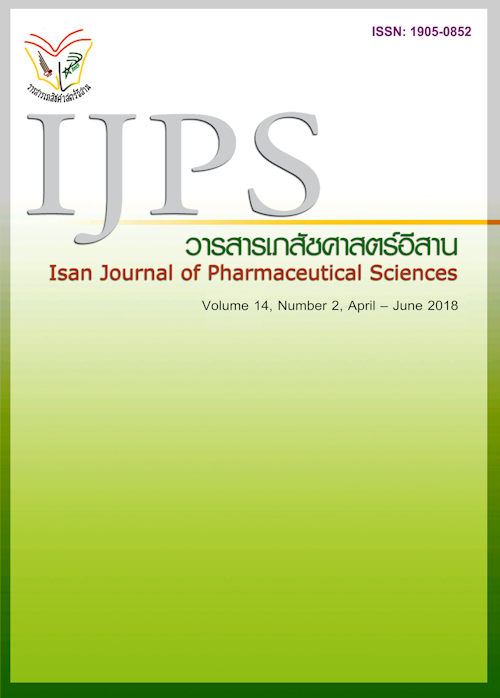A new drug for Parkinson’s Disease Psychosis : Pimavanserin
Main Article Content
Abstract
Parkinson’s disease psychosis (PDP) is common problem in late stage of Parkinson’s disease. Parkinson’s disease psychosis patients present with visual hallucinations and delusions. The prevalence of Parkinson’s disease psychosis shows in a half of patients with Parkinson’s disease. The consequence of Parkinson’s disease psychosis affect both patients and caregivers. For patients with diagnosed of PDP, the increase risk of morbidity and mortality can occur and also increase caregiver burden. The diagnosis of Parkinson’s disease psychosis following The National Institute of Mental Health (NIMH) and the National Institute of Neurological Disorders and Stroke (NINDS) criteria that patient should has one of illusion, false sense of presence, hallucinations or delusion and the symptom must occur after received diagnosis of Parkinson’s disease. The recommendation for management of Parkinson’s disease psychosis is using clozapine because less effect on movement system. However, the use of clozapine should monitor for serious side effect that can result in life threatening. The development of agents for Parkinson’s disease psychosis has mechanism beyond dopaminergic system. Pimavanserin, 5-HT2A inverse agonist, study found it’s effective and safe in Parkinson’s disease psychosis patients. In 6-weeks clinical trials, pimavanserin decrease Parkinson’s disease-adapted scale for assessment of positive symptoms (SAPS-PD) score than placebo and no difference in term of adverse events. The US Food and Drug Administration (FDA) approve pimavanserin , the first in class of drug for Parkinson’s disease psychosis in the dose of 34 mg per day. However, pimavanserin still need more long term study to assess effectiveness and economics evaluation for use in clinical practice.
Article Details
In the case that some parts are used by others The author must Confirm that obtaining permission to use some of the original authors. And must attach evidence That the permission has been included
References
Chendo I, Ferreira JJ. Pimavanserin for the treatment of Parkinson's disease psychosis. Expert Opin Pharmacother 2016; 17(15): 2115-2124.
Citrome L, Norton JC, Chi-Burris K, Demos G. Pimavanserin for the treatment of Parkinson's disease psychosis: number needed to treat, number needed to harm, and likelihood to be helped or harmed CNS Spectr 2017. 1-11.
Cummings J, Isaacson S, Mills R, et al. Pimavanserin for patients with Parkinson's disease psychosis: a randomised, placebo-controlled phase 3 trial. Lancet 2014; 383(9916) : 533-540.
Forsaa EB, Larsen JP, Wentzel-Larsen T, Alves G. What predicts mortality in Parkinson disease?: a prospective population-based long-term study. Neurology 2010; 75(14) : 1270-1276.
Forsaa EB, Larsen JP, Wentzel-Larsen T, et al. A 12-year population-based study of psychosis in Parkinson disease. Arch Neurol 2010; 67(8): 996-1001.
Goldman JG, Holden S. Treatment of psychosis and dementia in Parkinson's disease. Curr Treat Options Neurol 2014; 16(3) : 281.
Hacksell U, Burstein ES, McFarland K, Mills RG, Williams H. On the discovery and development of pimavanserin: a novel drug candidate for Parkinson's psychosis. Neurochem Res 2014; 39(10): 2008-2017.
Holt RJ, Sklar AR, Darkow T, Goldberg GA, Johnson JC, Harley CR. Prevalence of Parkinson's disease-induced psychosis in a large U.S. managed care population. J Neuropsychiatry Clin Neurosci 2010; 22(1): 105-110.
Kalia LV, Lang AE. Parkinson's disease. Lancet 2015; 386(9996): 896-912.
Levin J, Hasan A, Hoglinger GU. Psychosis in Parkinson's disease: identification, prevention and treatment. J Neural Transm (Vienna) 2016; 123(1): 45-50.
Mathis MV, Muoio BM, Andreason P, et al. The US Food and Drug Administration's Perspective on the New Antipsychotic Pimavanserin. J Clin Psychiatry 2017; 78(6): e668-e673.
Meltzer HY, Mills R, Revell S, et al. Pimavanserin, a serotonin(2A) receptor inverse agonist, for the treatment of parkinson's disease psychosis. Neuropsychopharmacology 2010; 35(4): 881-892.
Mills R, Isaacson S, Azulay J-P, et al. Long-term effectiveness of NUPLAZID™ (pimavanserin) in PD psychosis: Data from 2 open-label studies. Parkinsonism & Related Disorders 2015; 22: e28.
Miyasaki JM, Shannon K, Voon V, et al. Practice Parameter: evaluation and treatment of depression, psychosis, and dementia in Parkinson disease (an evidence-based review): report of the Quality Standards Subcommittee of the American Academy of Neurology. Neurology 2006; 66(7): 996-1002.
Rascol O, Lozano A, Stern M, Poewe W. Milestones in Parkinson's disease therapeutics. Mov Disord 2011; 26(6): 1072-1082.
Ravina B, Marder K, Fernandez HH, et al. Diagnostic criteria for psychosis in Parkinson's disease: report of an NINDS, NIMH work group. Mov Disord 2007; 22(8): 1061-1068.
Stahl SM. Mechanism of action of pimavanserin in Parkinson's disease psychosis: targeting serotonin 5HT2A and 5HT2C receptors. CNS Spectr 2016; 21(4): 271-275.
Vanover KE, Robbins-Weilert D, Wilbraham DG, et al. Pharmacokinetics, tolerability, and safety of ACP-103 following single or multiple oral dose administration in healthy volunteers. J Clin Pharmacol 2007; 47(6): 704-714.
Zahodne LB, Fernandez HH. Parkinson's psychosis. Curr Treat Options Neurol 2010; 12(3): 200-211.


